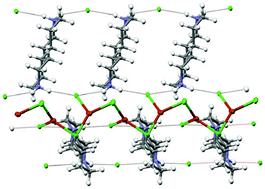A new copper chloride chain by supported hydrogen bonding†
Abstract
In the current paper we introduce a new type of Cu–Cl

* Corresponding authors
a
Department of Chemistry, University of Jyväskylä, P.O. Box 35, FI-40014, Finland
E-mail:
matti.tuikka@jyu.fi
b
School of Chemical Technology, Aalto University, FI-00076 Aalto, Finland
E-mail:
ukersen@hotmail.com
c
Department of Chemistry, University of Jyväskylä, P.O. Box 35, FI-40014, Finland
E-mail:
matti.o.haukka@jyu.fi
In the current paper we introduce a new type of Cu–Cl

 Please wait while we load your content...
Something went wrong. Try again?
Please wait while we load your content...
Something went wrong. Try again?
M. Tuikka, Ü. Kersen and M. Haukka, CrystEngComm, 2013, 15, 6177 DOI: 10.1039/C3CE40692J
To request permission to reproduce material from this article, please go to the Copyright Clearance Center request page.
If you are an author contributing to an RSC publication, you do not need to request permission provided correct acknowledgement is given.
If you are the author of this article, you do not need to request permission to reproduce figures and diagrams provided correct acknowledgement is given. If you want to reproduce the whole article in a third-party publication (excluding your thesis/dissertation for which permission is not required) please go to the Copyright Clearance Center request page.
Read more about how to correctly acknowledge RSC content.
 Fetching data from CrossRef.
Fetching data from CrossRef.
This may take some time to load.
Loading related content
